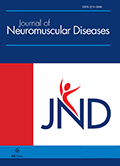Authors: Crowe, Kelly E. | Zygmunt, Deborah A. | Heller, Kristin | Rodino-Klapac, Louise | Noguchi, Satoru | Nishino, Ichizo | Martin, Paul T.
Article Type:
Research Article
Abstract:
Background: GNE myopathy (GNEM) is a rare, adult-onset, inclusion body myopathy that results from mutations in the GNE gene. GNE encodes UDP-GlcNAc epimerase/ManNAc-6 kinase, a protein with two enzymatic activities that comprise the committed step in biosynthesis of sialic acid (SA), an essential glycan that appears on the terminal positions of many extracellular oligosaccharide chains. These GNE mutations can cause a reduction of SA in many tissues, although pathology is restricted to skeletal muscles through a poorly understood mechanism. Objective: Despite recent advances in the field, it remains unclear which therapeutic avenue is most promising
…for the restoration of SA level in skeletal muscle affected by GNEM. Our objective was to assess dietary and gene therapy strategies for GNEM in Cmah -deficient GNED 207V Tg Gne-/- mice, a model that allows for the visualization of orally delivered N-glycolylneuraminic acid (Neu5Gc), one of the two predominant SA forms in muscle. Methods: Methods included in situ physiology studies of the tibialis anterior muscle, studies of ambulation and limb grip strength, and muscle staining using MAA, SNA, and anti-Neu5Gc antibody, along with qPCR, qRT-PCR, western blot, and HPLC studies to assess virally introduced DNA, GNE gene expression, GNE protein expression, and SA expression. Results: We found that a diet enriched in Neu5Gc-containing glycoproteins had no impact on Neu5Gc immunostaining in muscles of GNEM model mice. Delivery of a single high dose oral Neu5Gc therapy, however, did increase Neu5Gc immunostaining, though to levels below those found in wild type mice. Delivery of a single dose of GNE gene therapy using a recombinant Adeno Associated Virus (rAAV) vector with a liver-specific or a muscle-specific promoter both caused increased muscle Neu5Gc immunostaining that exceeded that seen with single dose monosaccharide therapy. Conclusions: Our findings indicate that dietary loading of Neu5Gc-containing glycoproteins is not effective in increasing muscle Neu5Gc expression, while single dose oral Neu5Gc monosaccharide or GNE gene therapy are. Neu5Gc immunostaining, however, showed greater changes than did lectin staining or HPLC analysis. Taken together, these results suggest that Neu5Gc immunostaining may be more sensitive technique to follow SA expression than other more commonly used methods and that liver expression of GNE may contribute overall muscle SA content.
Show more
Keywords: Myopathy, sialic acid, gene therapy, AAV, hereditary inclusion body myopathy
DOI: 10.3233/JND-200575
Citation: Journal of Neuromuscular Diseases,
vol. 9, no. 1, pp. 53-71, 2022
Price: EUR 27.50





